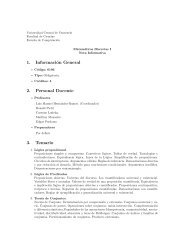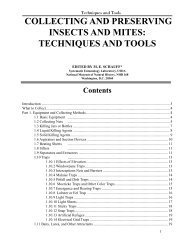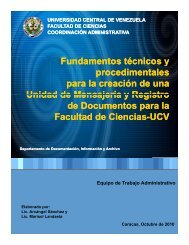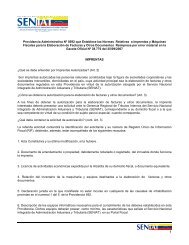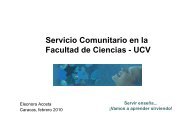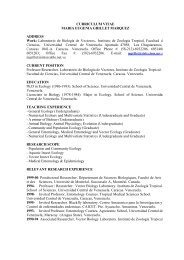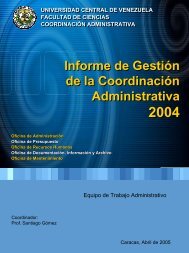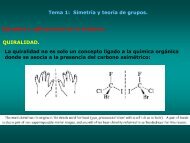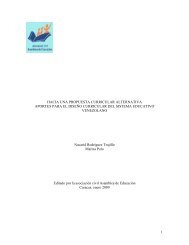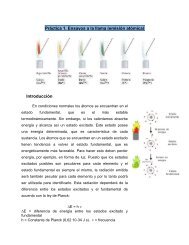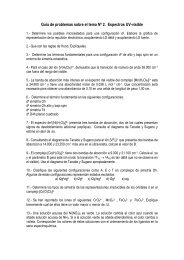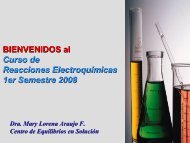Loop-mediated isothermal amplification test for Trypanosoma vivax ...
Loop-mediated isothermal amplification test for Trypanosoma vivax ...
Loop-mediated isothermal amplification test for Trypanosoma vivax ...
- No tags were found...
Create successful ePaper yourself
Turn your PDF publications into a flip-book with our unique Google optimized e-Paper software.
G ModelVETPAR-5767; No. of Pages 5ARTICLE IN PRESS4 Z.K. Njiru et al. / Veterinary Parasitology xxx (2011) xxx–xxxto a thermal cycler, the need <strong>for</strong> power to heat water is stilla drawback. As such, alternative sources of heat such asexothermal chemicals and battery operated units need tobe considered. The recorded analytical sensitivity of 1 trypanosome/mlis a good detection level <strong>for</strong> T. <strong>vivax</strong>, notingits low parasitaemia in hosts. However, experience showsthat these laboratory based sensitivities may not necessarilybe reproducible under field conditions (Njiru et al.,2008). Thus, rigorous T. <strong>vivax</strong> LAMP field evaluations willbe the next major step.The potential usefulness of T. <strong>vivax</strong> LAMP as a point ofuse <strong>test</strong> is demonstrated by the ability of the new assayto amplify target DNA from mixed infections and supernatantprepared from spiked bovine blood, meaning thatDNA extraction may not be necessary. We recorded noinhibition of LAMP reaction or <strong>for</strong>mation of non-specificproduct with the use of up to 3-l of supernatant per 25-l. The possibility of using partially processed templatesbypasses extraction, a contamination prone step, shortensthe LAMP <strong>test</strong> and improves detection limit since less DNAis lost. Thus T. <strong>vivax</strong> LAMP assay reported in this work hasa clear advantage over PCR in that the <strong>test</strong> is robust, simpleand requires less instrumentation to make a diagnosis.Further work is required to define the supernatant preparationprotocols and analyze various extraction and storagebuffers that may help improve supernatant viability.It is crucial to ensure that T. <strong>vivax</strong> LAMP amplifies thecorrect product since the LAMP strategy does not offer thechance of confirming the end product unlike in PCR whereDNA marker can be used to size the amplicon. In this workthe resulting LAMP product was confirmed through restrictionenzyme digestion with NdeI which gave the predictedtwo products of ∼80 bp and 140 bp sizes respectively. Inaddition, the acquisition and analysis of the melt curves(post LAMP <strong>amplification</strong>) not only showed reproduciblemelt curves but revealed consistent T m of ∼90 ◦ C indicatingsimilar sequence. A combination of these results andthree negative controls per each <strong>test</strong> run increases our confidencein using the non-specific SYBR ® Green I to progressthe <strong>test</strong> <strong>for</strong> further analysis. However absolute detection ofthe correct LAMP product can be achieved through the useof probes that bind to specific sequence within the LAMPproduct followed by detection of the resulting probe-LAMPproduct complex through a simple lateral flow dipstick(LFD) <strong>for</strong>mat (Njiru, 2011). This method has downside inthat it is expensive compared to non-specific dyes, howeverthe need <strong>for</strong> absolute diagnosis and the advantages ofusing supernatant as template merits further research inconverting LAMP/LFD into a single <strong>amplification</strong> and detectionsystem, a device that our research group is workingon.The diagnosis of T. <strong>vivax</strong> is the most challenging amongthe animal pathogenic trypanosomes. There<strong>for</strong>e the developmentof LAMP <strong>test</strong> based on a target used to develop themost sensitive PCR <strong>test</strong> (Masiga et al., 1992) may potentiallyimprove the field diagnosis of this parasite. This perceptionis supported by the recorded superior sensitivity of LAMP<strong>test</strong> over PCR <strong>test</strong>s in the analysis of T. <strong>vivax</strong> and bovine samplescollected from the endemic area (Table 2). The T. <strong>vivax</strong>LAMP was specific and no cross reactivity was recordedwith other trypanosomes, however it failed to detect threesamples that were microscopically positive at the time ofpreservation. Two ideas could be advanced <strong>for</strong> this observation:(i) that the pathogen DNA concentration in thetemplate was below the LAMP detection level and/or (ii)the possibility that the three samples contained T. <strong>vivax</strong> thathad different satellite repeat DNA sequence. Previous studieshave identified isolates from East Africa (albeit few) thatare not detected by satellite DNA based PCR <strong>test</strong> (Adamset al., 2010). It is worth noting that the overall percentageof these isolates is so low and only a handful of themexist in the laboratories. Studies to sequence the satelliteDNA of the three isolates will be undertaken to reveal theirsequence composition.An initial comprehensive analysis of the bovine fieldsamples showed a trypanosome prevalence of 86/357(24.1%) consisting of 71 single infections (27 Trypanozoon,33 Nannomonas and 11 T. <strong>vivax</strong>) and 15 double infections (7Tbr/Tcs, 4Tbr/Tv and 4 Tcs/Tv) (Njiru et al., 2005). Analysisof the same samples with T. <strong>vivax</strong> LAMP not only confirmedthe T. <strong>vivax</strong> positive samples but picked an extra eight (8) T.<strong>vivax</strong> infected animals that were previously negative withPCR. Since DNA degradation may have occurred over theyears due to sample storage, the prevalence of this parasitecould have even be higher than earlier reported. Such undiagnosedcases continue to act as a source of new infectionin the field. Since mixed infection is a common occurrencein the field, research on development of a universal LAMP<strong>test</strong> <strong>for</strong> pathogenic trypanosomes need to be considered.5. ConclusionIt is a routine procedure <strong>for</strong> animal blood to be collectedfrom the field and taken to the laboratory <strong>for</strong> analysis.Moreover, the animals that are treated during the field visitsare those that are microscopically positive and/or thosethat show convincing clinical symptoms as per the opinionof the treating veterinary officer. Once the laboratoryanalysis are complete, it is not always possible to go backand treat the sick animals due to expenses involved andthe migrating nature of the cattle owners. The LAMP technologydescribed here shows potential <strong>for</strong> field diagnosisand may be a future viable alternative to laboratory diagnosis.However be<strong>for</strong>e T. <strong>vivax</strong> LAMP can be deployed underfield conditions as a point of use <strong>test</strong>, a number of issueswill need to be addressed, namely; (i) template preparationprotocols, (ii) development of lyophilized reagents that arestable in the endemic areas, (iii) source of power <strong>for</strong> <strong>amplification</strong>and (iv) development of accurate visual detection<strong>for</strong>mats. Until these objectives are realized, the T. <strong>vivax</strong>LAMP <strong>test</strong> will be a valuable tool in mid-tier laboratorieswhere it may compliment PCR <strong>test</strong>.AcknowledgementsThis work was funded through the University ofQueensland postgraduate grant to Zablon Njiru and thesamples analyzed were contributed by Trypanosomiasisresearch Center, Kenya. The views expressed by the authorsdo not necessarily reflect the views of their respective institutes.Please cite this article in press as: Njiru, Z.K., et al., <strong>Loop</strong>-<strong>mediated</strong> <strong>isothermal</strong> <strong>amplification</strong> <strong>test</strong> <strong>for</strong> <strong>Trypanosoma</strong> <strong>vivax</strong>based on satellite repeat DNA. Vet. Parasitol. (2011), doi:10.1016/j.vetpar.2011.03.021



